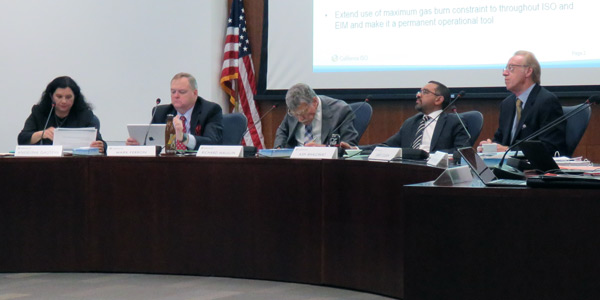By Jason Fordney
FOLSOM, Calif. — The CAISO Board of Governors last week approved a set of market rules designed to aid the integration of distributed energy resources and transmission-connected energy storage into the ISO’s markets.
ISO staff closely consulted with market participants over the past year to develop the Energy Storage and Distributed Energy Resources (ESDER) Phase 2 proposal in response to the growing volume of distributed resources in California. The board’s approval of the measure sends the rules to FERC for a new round of comments and review.
DER developers such as energy storage companies are aggressively moving into an area that is seen as increasingly important and profitable — balancing renewables and addressing California’s “duck curve,” which graphically describes the impact of the variable output of solar generation on the ISO grid at different times of the day. (See Report: Calif. ‘Duck Curve’ Growing Faster than Expected.)
CAISO CEO Steve Berberich told the board that ESDER Phase 2 is part of a broader strategy to accommodate emerging technologies, including demand response, storage and other new types of systems that might be coming to the grid.
“We think that leveraging them is going to be critical to how we manage the grid, and help decarbonize the grid as well,” Berberich said. He added that “we are committed to continue to work with all those that provide these services,” and with the California Public Utilities Commission.
Storage makes up 20% of the resources in CAISO’s interconnection queue, which contains 325 projects totaling 58,000 MW, according to the grid operator. Renewables represent 68% of the generation waiting to interconnect, while conventional resources account for 9%.
Beyond 10-in-10
As part of ESDER, the board approved a set of alternative energy usage baselines to assess the performance of proxy demand resources, which are DER aggregations of retail customers. It also approved new rules that distinguish between charging energy and station power for storage resources, and a net benefits test for DR resources that participate in the Energy Imbalance Market (EIM).
The ISO currently relies on a “10-in-10” baseline methodology that works well for many large commercial and industrial customers but not for all customer types, CAISO said in briefing documents. Using the 10-in-10 methodology, the ISO calculates a baseline by examining the 45 days prior to a trade date and finding 10 “like” days in which no DR was required. It then uses hourly average meter data to create a baseline representing a typical load profile, and the resource is paid for reducing usage below the baseline.
Under the new proposal, baselines for residential resources would be based on a four-day weather match that estimates what electricity use would have been in the absence of DR dispatch under similar weather and on similar days, using a control group of similar users.
Commercial baselines would be based on the 10-in-10 method with a 20% adjustment cap, an average of the previous five days and a control group. Baselines are adjusted using actual load data in the hours preceding a DR event to better reflect variables that might not appear in the historical data.
The package approved by the board also includes a new definition for station power, to distinguish between power used to charge a storage device and energy for station power. It simplifies the definition of station power to align with local regulatory authorities.
The newly approved initiative also incorporates additional gas pricing indices into the “net benefits test” that determines a price threshold to indicate when DR provides a net benefit to all purchasers by reducing the wholesale price. The price threshold is used to determine if an adjustment is required to the settlement of the load-serving entity that procured the load curtailed by the DR resource.
Greg Cook, CAISO director of infrastructure and policy, told the board that the measure allows the ISO to “take into account that the real-time market now has a much broader footprint than just the ISO balancing area, and we should take that into account in the calculation of the net benefits test.”
‘All Hands on Deck’

CAISO stakeholders are supportive of the new baselines and the station power proposals. Tesla and other storage companies urged CAISO to move quickly to develop a new DER product that would pay for storage to take excess generation, but the ISO said that measure needs more development, and it was not included in ESDER Phase 2. (See Storage Advocates Urge CAISO on DR Product.)
Ted Ko, director of policy for energy storage company Stem, told the board that the ESDER package and DER will be an important tool in reducing the duck curve and curtailments of excess renewables.
“It seems like a time for all hands on deck,” Ko said. “We should be looking for all solutions to reduce that curtailment and bring all solutions to bear.” This also includes developing the EIM and regionalization of CAISO, he said.
Stem has been participating in CAISO as a proxy demand resource and has contracts to deploy more than 400 MWh of DER over the next several years in California. The company needs the ISO to provide a market signal to know when charging is most helpful to the grid, Ko said, and technical and policy guidance from the ISO and other companies. He said that Stem and other companies want the ISO to “take this leadership position with urgency” on developing a load consumption proposal.
Berberich said that CAISO will brief the board at its next meeting on the integration of the load-consumption DER product. There are jurisdictional issues to be worked out with the PUC, he said, and he asked storage companies to contribute their ideas.



